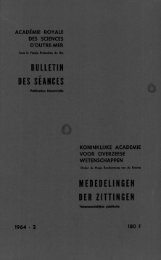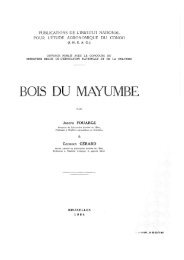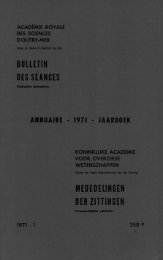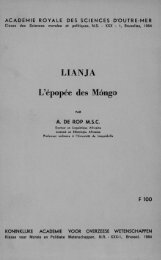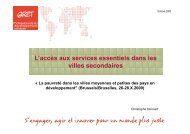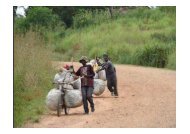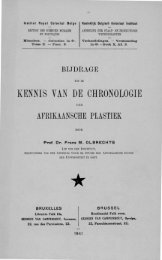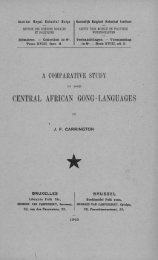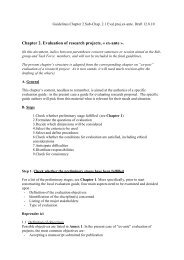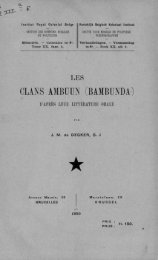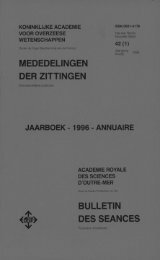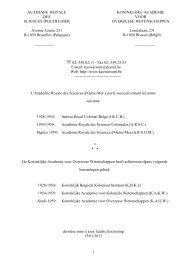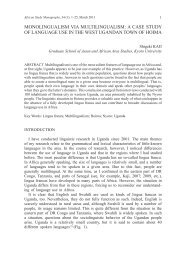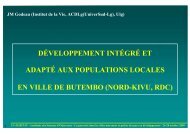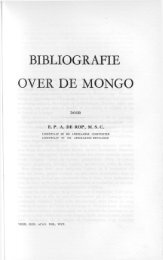KONINKLIJKE ACADEMIE VOOR OVERZEESE WETENSCHAPPEN ...
KONINKLIJKE ACADEMIE VOOR OVERZEESE WETENSCHAPPEN ...
KONINKLIJKE ACADEMIE VOOR OVERZEESE WETENSCHAPPEN ...
Create successful ePaper yourself
Turn your PDF publications into a flip-book with our unique Google optimized e-Paper software.
— 338 —<br />
Reference System). In totaal werden tussen Kinshasa en Lubumbashi vijfendertig nieuwe<br />
punten ingeplant, opgemeten en berekend. De nauwkeurigheid ( 1 °) van de coördinaten<br />
t.o.v. het ITRF-net is beter dan 1 cm. Het bepalen van de transformatieparameters tussen<br />
het nieuwe globale net en het oude lokale net verliep niet zo vlot. De voornaamste oorzaak<br />
ervan was dat het merendeel van de vroegere geodetische punten vernietigd waren of<br />
dat het onmogelijk was om nog vast te stellen in welke kaartvoorstelling de coördinaten<br />
gegeven waren.<br />
M ots-cles. — Congo; GPS; Géodésie; Projections cartographiques; ITRF.<br />
R esume. — Révision du tiers méridional du réseau géodésique de la République<br />
Démocratique du Congo. — En collaboration avec la firme privée belge «Bureau GM»,<br />
l’Institut géographique national (IGN) de Belgique a effectué, entre mars et août 2005,<br />
une révision de la partie méridionale du réseau géodésique du Congo. La firme privée a<br />
fourni l’appui logistique indispensable, tandis que l’IGN s’est chargé de tous les aspects<br />
scientifiques et techniques du projet en utilisant toutes les méthodes d’observation et<br />
toutes les techniques que le système GPS (Global Positioning System) permet.<br />
Contrairement à ce qui se faisait dans le passé (chaque pays définissait son propre système<br />
de référence local), la partie révisée du réseau géodésique congolais a été intégrée<br />
dans le réseau global ITRS (International Terrestrial Reference System). Au total, trente-<br />
cinq nouveaux points ont été implantés, levés et calculés entre Kinshasa et Lubumbashi.<br />
La précision (1 °) des coordonnées vis-à-vis du réseau ITRF est supérieure à 1 cm. La<br />
définition des paramètres de transformation entre le nouveau réseau global et l’ancien<br />
réseau local n’a pas été chose aisée. Ceci est surtout dû au fait que la plupart des anciens<br />
points géodésiques étaient détruits ou qu’il était impossible de savoir dans quel système<br />
de projection les coordonnées avaient été calculées.<br />
Introduction<br />
In August 2003, COPIREP (Comitéde Pilotage de la Réforme des Entreprises<br />
Publiques) awarded the revision of the southern part of the Geodetic Net of the<br />
DRC to the Belgian private company “Bureau GM”. The company took care of<br />
all logistic problems but sought scientific and technical support at the National<br />
Geographic Institute of Belgium (NGI). The main purpose of the project was to<br />
supply the National Geographic Institute of Congo (IGC) and the Mine Cadastre<br />
(CAMI) with a network of thirty-five points stretching along the southern border<br />
of Congo, from Kinshasa to Lubumbashi. These thirty-five points could then be<br />
used by both institutes for further densification, each according to their own<br />
needs and responsibilities.<br />
From the start, it was clear that GPS should be used as the surveying tool and<br />
that the new network should be linked to the International Terrestrial Reference<br />
Frame (ITRF). More information on ITRF is given in [1]* and [2],<br />
* Numbers in brackets [ ] refer to the notes, pp. 349-350.



